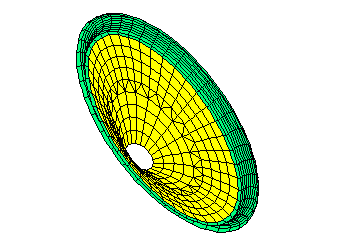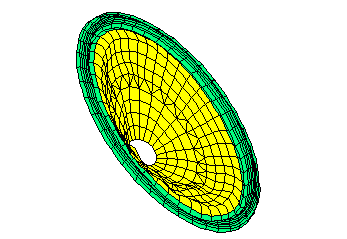
Elliptical cone (pistonic)

Elliptical cone (breakup)
Benefits of Acoustic FE/BE Analysis in Loudspeaker Design |
|
|
Analytical tools such as the finite and boundary element methods can be used
to assist in the design process. These techniques can potentially permit
consideration of very radical changes using non-standard components, which
would be very expensive to construct on a one-off basis, thus accelerating the
design cycle. They also have a role to play in helping the engineer comprehend
the phenomena and hence make more efficient design changes.
|
|
|
 Elliptical cone (pistonic)
|
 Elliptical cone (breakup)
|
|
|
A common performance indicator for a loudspeaker box is the pressure against
frequency response at some point on axis in front of it. Ideally this should
be fairly flat for a constant electrical input against frequency. However
there are many phenomena which affect the final result, e.g.
If the designer does not understand why a particular
system is producing its response then new models can only change at an evolutionary
pace. To acquire this comprehension it is useful to isolate different phenomena.
Sometimes this can be done experimentally, e.g. using an anechoic chamber to
eliminate reflections, or using an anechoic half chamber (i.e. with one rigid wall)
to remove diffraction by edges. With an analytical approach it is possible to
visualise the complete pressure field and the structural deformed shape. It is
also possible to investigate design changes, even those which are impossible
experimentally, e.g. eliminating air behind the cone, which improves the
understanding of why a system works as it does.
|
|
|
Back |